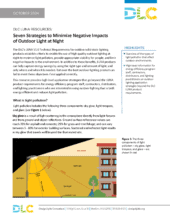Industry Reports, Research, & DLC Resources
Use the category filter to the right to find the specific resources.

NLC-HVAC Integration Toolkit
The NLC-HVAC Integration Toolkit will help energy efficiency programs, integrators, and market actors successfully identify, pursue, and implement NLC-HVAC integration projects. Download the toolkit (zip file) for a decision tree, a handbook, case studies, and templates that will set your project up for success.
KEY TAKEAWAYS
- Decide if a project is a good candidate for integration and avoid projects where success is unlikely
- Learn about successful integrations through a list of published case studies searchable by building type
- See recommended best practices for integration and use an example construction integration specification

Excerpt – Pathways to Connected Lighting
An excerpt of our playbook, "Pathways to Connected Lighting", that helps energy efficiency programs meet target savings goals with NLC and HVAC integration with lighting controls.
Key Takeaways
- Learn what is included in the playbook
- Learn how to assess your program and about strategies to level up savings from connected lighting.

Memo: Clarifications to the 2020 Report: “Energy Savings from Networked Lighting Control (NLC) Systems With and Without LLLC”
This memo provides clarity on interpreting the presented information and further elaborates on key points in the 2020 Savings Report.
Key Takeaways
- The control savings factors (CSFs) in the 2020 report represent average savings across a diverse set of projects, which include both optimally and sub-optimally programmed systems. Energy efficiency programs that implement mechanisms to specify or verify proper NLC system programming can expect higher savings, as CSFs are influenced by system setup and optimization.
- High-end trim and other control strategies deliver distinct savings. While high-end trim reduces the lighting load first, other strategies save energy from the remaining load. To maximize savings, EE programs can incentivize and measure these strategies separately, using the CSFs provided in the updated report for independent assessment.

Expedited Horticultural Lighting Applications
The DLC is offering a limited time option to expedite your horticultural application review. Learn how!
Key Takeaways
- Policies, review timeframes, and fees for expediting your horticultural lighting application.

Seven Strategies to Minimize Negative Impacts of Outdoor Light at Night
This resource provides high-level application strategies that go beyond the LUNA product requirements for energy efficiency program staff, contractors, distributors, and lighting practitioners who are interested in using outdoor lighting that is both energy efficient and reduces light pollution.
Key Takeaways
- Overview of the types of light pollution that affect outdoor environments.
- High-level information for energy efficiency program staff, contractors, distributors, and lighting practitioners on outdoor lighting application strategies beyond the DLC LUNA product requirements.

Application Guidance for LUNA V1.0
This resource explains common misunderstandings of the LUNA Technical Requirements that impact application review and timing and provides information about specific items to pay particular attention to on the application form.
Key Takeaways
- Detailed information on how to ensure a complete LUNA application.
Still need help?
© 2025 DesignLights Consortium. The DesignLights Consortium is a project of Efficiency Forward, Inc., a non-profit 501(c)3 organization. Privacy Policy Terms of Use

